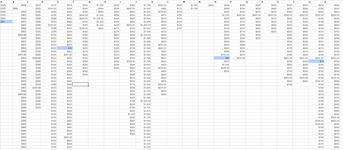placidbomb
New Member
- Joined
- Sep 9, 2024
- Messages
- 2
- Office Version
- 365
- Platform
- MacOS
Hi guys,
Am relatively new to excel and although I do have some experience with using formula, this is a scenario that I can't seem to be able to crack. I have a set of data, where I need to identify and remove outlying values from the data set. These outlying values are usually too small or too big causing the average to skew by a lot. I am trying to avoid that. In the attached sample data sheet I have manually selected the values (highlighted in blue) that I want to remove in real life scenario. But I would like to know how I can remove those outlying values if the data set was very large. In real scenario, I won't have the time or the accuracy to locate these outlying values one by one since I will have hundreds of columns. Also not required, but it would be helpful if there was a way to close the empty cell gaps, once those outlying values have been deleted. Thank you very much.
Am relatively new to excel and although I do have some experience with using formula, this is a scenario that I can't seem to be able to crack. I have a set of data, where I need to identify and remove outlying values from the data set. These outlying values are usually too small or too big causing the average to skew by a lot. I am trying to avoid that. In the attached sample data sheet I have manually selected the values (highlighted in blue) that I want to remove in real life scenario. But I would like to know how I can remove those outlying values if the data set was very large. In real scenario, I won't have the time or the accuracy to locate these outlying values one by one since I will have hundreds of columns. Also not required, but it would be helpful if there was a way to close the empty cell gaps, once those outlying values have been deleted. Thank you very much.






